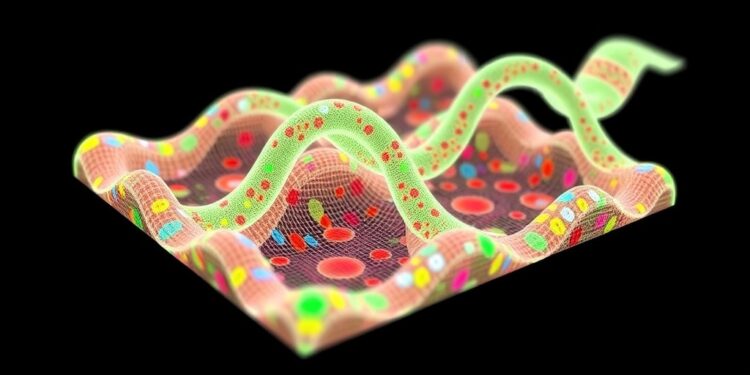
In a groundbreaking development in the field of genomic research, a team of scientists from Tsukuba, Japan, has made significant strides in the visualization and analysis of gene expression patterns. Understanding the three-dimensional spatial distribution of gene expression is crucial for scientists seeking to decode the complex roles genes play in biological processes. This insight into gene activity can lead to breakthroughs in various disciplines, including developmental biology, disease research, and regenerative medicine. The innovative method introduced by researchers is known as RNA tomography, which offers an avenue for creating detailed 3D maps of gene expression within biological tissues.
RNA tomography involves a sophisticated process that begins with the preparation of frozen tissue sections aligned along three orthogonal axes. Each section undergoes RNA sequencing—a powerful technique that allows researchers to analyze gene expression on a cellular level. These sequencing results are then superimposed to reconstruct a comprehensive three-dimensional model that illustrates where specific genes are active or inactive within the tissue. While this method has proven effective, it has also posed challenges for many researchers due to the high level of computational expertise required to process the resulting data.
Recognizing the need for a more accessible solution, the research team developed a user-friendly software suite known as tomoseqr. This innovative tool is specifically designed to facilitate the estimation of 3D spatial gene expression distribution. With a user-centric graphical interface, tomoseqr simplifies the cumbersome task of creating tissue morphology data and aids researchers in visualizing 3D gene expression models. By offering a free and intuitive platform, tomoseqr democratizes this advanced analysis, enabling a wider range of researchers to explore gene functions without the steep learning curve associated with traditional computational methods.
In practical applications, the effectiveness of tomoseqr has been demonstrated through studies involving zebrafish, a model organism frequently utilized in genetic research due to its transparent embryos and rapid development. By applying this software to the gene expression data from zebrafish, researchers successfully reproduced previously known gene expression patterns, thereby validating the tool’s accuracy and reliability. This significant achievement not only showcases the software’s potential but also affirms its capability to handle complex biological data to yield meaningful insights.
Furthermore, researchers have extended the fascinating applications of tomoseqr beyond zebrafish, utilizing the software to analyze around 18,000 genes in planarians. This intriguing creature is admired for its remarkable regenerative abilities, which provide a captivating area of study for scientists aiming to unlock the secrets of tissue regeneration. By mapping the 3D spatial distribution of gene expression across this organism, researchers were able to identify genes that exhibited extraordinary spatial fluctuations, suggesting these genes might play critical roles in various biological functions such as wound healing and regeneration.
The adoption of tomoseqr by Bioconductor, a prominent global platform for life science software, signals a substantial step forward for the advancement of computational biology. Bioconductor is widely recognized for providing robust tools that streamline bioinformatics research, and the inclusion of tomoseqr permits even greater collaboration and resource sharing within the scientific community. As researchers from different fields leverage the capabilities of tomoseqr, it is poised to spark innovation and drive novel discoveries in gene expression analysis.
The implications of these findings extend far beyond the laboratory; they open up new possibilities for applicable therapies in medicine. Researchers are optimistic that the insights gained from utilizing tomoseqr can facilitate advancements in the understanding of genetic diseases and the development of targeted treatments. The enhanced capacity to analyze spatial gene expression means that researchers can better identify gene functions essential to health and disease, serving as a vital tool in the quest to combat various medical conditions.
Moreover, tomoseqr’s user-friendly design signifies a paradigm shift in how researchers with limited computational backgrounds can participate in genomic studies. This accessibility could lead to increased collaboration among biologists, computational scientists, and clinicians, enriching interdisciplinary research and potentially leading to faster scientific breakthroughs.
The power of visualization in science cannot be understated, and tomoseqr exemplifies how innovative tools can transform complex data into actionable insights. By providing a tangible means to observe the intricacies of gene expression in three dimensions, this software not only enhances our understanding of fundamental biological processes but also serves as a foundation for future research endeavors.
As this research continues to evolve, the scientists involved are compelled to explore new frontiers in gene expression analysis. The potential for tomoseqr to impact studies on various model organisms emphasises its versatile nature, suggesting that future applications may reveal insights into evolutionary biology, development, and environmental responses at a molecular level.
In conclusion, the development of tomoseqr represents a significant leap forward in the field of bioinformatics. By bridging the gap between complex genomic data and accessible analysis tools, it provides researchers with the means to explore the depths of gene expression in ways that were previously limited by technical expertise. With the capability to map and visualize gene activity in three dimensions, tomoseqr is not merely a software tool; it is a catalyst for discovery in the realms of genetics and molecular biology.
The fusion of advanced technology and biological inquiry is an exciting frontier, and developments like tomoseqr will undoubtedly shape the future of genomic research, fostering a deeper understanding of how life operates at a molecular scale while laying the groundwork for transformative applications in medicine and therapeutic strategies.
Subject of Research: 3D Spatial Gene Expression Analysis
Article Title: tomoseqr: a Bioconductor package for spatial reconstruction and visualization of 3D gene expression patterns based on RNA tomography
News Publication Date: 8-Jan-2025
Web References: https://doi.org/10.1371/journal.pone.0311296
References: N/A
Image Credits: N/A
Keywords: 3D gene mapping, RNA tomography, gene expression visualization, computational biology, Bioconductor, zebrafish, planarians, regenerative medicine, tissue morphology analysis, gene function discovery, bioinformatics tools, molecular biology.
Tags: 3D gene expression mappingcomputational biology accessibilitydevelopmental biology breakthroughsdisease research innovationsgene activity analysisgenomic research advancementsregenerative medicine applicationsRNA sequencing techniquesRNA tomography softwarespatial distribution of genestissue section preparation methodsvisualization of gene expression




